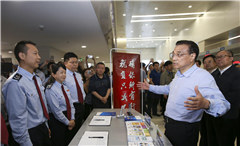China’s capital outflows ease on firmer economy, yuan
2017-04-20
Xinhua
BEIJING — Pressure from capital flight has eased off markedly as firmer economic growth renewed foreign investment and the yuan steered clear of depreciation.
Net forex sales by Chinese banks rose slightly in March, official data showed on April 20.
Banks bought $145 billion of foreign currencies and sold $156.6 billion, resulting in net sales of $11.6 billion last month, according to the State Administration of Foreign Exchange (SAFE). The deficit was up from February’s $10.1 billion but lower than the $19.2 billion January.
“Generally speaking, the pressure of cross-border capital outflow eased significantly in the first quarter. Supply and demand of foreign currencies have become more balanced,” said SAFE spokesperson Wang Chunying at a news conference.
In Q1 banks’ net forex sales stood at $40.9 billion, down 67 percent from a year ago.
There has been concern about capital flight since the second half of 2016, when the economy was facing downward pressure and the yuan was on a losing streak against the US dollar. The yuan has since gradually recovered.
The central parity rate of the yuan weakened 128 basis points to 6.8792 against the US dollar on April 20, according to the China Foreign Exchange Trade System. Forex reserves also rose in March for the second month to $3.0091 trillion first back-to-back increase since April 2016. In January, reserves slipped below the 3-trillion-dollar mark.
Lian Ping, chief economist at the Bank of Communications, predicts China’s cross-border capital flows will maintain stability as the impact of US rate cuts has lightened. It may even be possible to see net inflows or appreciation of the yuan.
The International Monetary Fund said in a report that the capital outflow pressure could be exacerbated by tightening of global financial conditions or a shift toward protectionism in advanced economies.
Wang admitted uncertainties from US rate hikes and economic conditions but said the market is accustomed to the US Federal Reserve’s policy changes.
“China’s forex reserves only edged down $1.4 billion in the first quarter when the US raised its interest rates for the third time since exiting quantitative easing,” Wang said, in contrast with $183.8 billion $155.9 billion in the first and second times.
Solid fundamentals and appeal to overseas investors will help capital flows move toward equilibrium, Wang said.
China ranked third in attracting foreign direct investment in 2016, after the United States and Britain, data from the United Nations Conference on Trade and Development showed.
CAPITAL CONTROL RULED OUT
The SAFE spokesperson dismissed concerns about capital controls, saying “the open window will never be closed.”
“China’s forex management will not turn back,” Wang said, adding that despite outflows, there were no new restrictions, only strengthened scrutiny on authentication.
Current account convertibility began about two decades ago, and gradual but steady liberalization of the yuan capital account has continued since then.
In February, the forex derivatives market was opened to some overseas non-central bank institutional investors to trade forwards, forex swaps and options.


